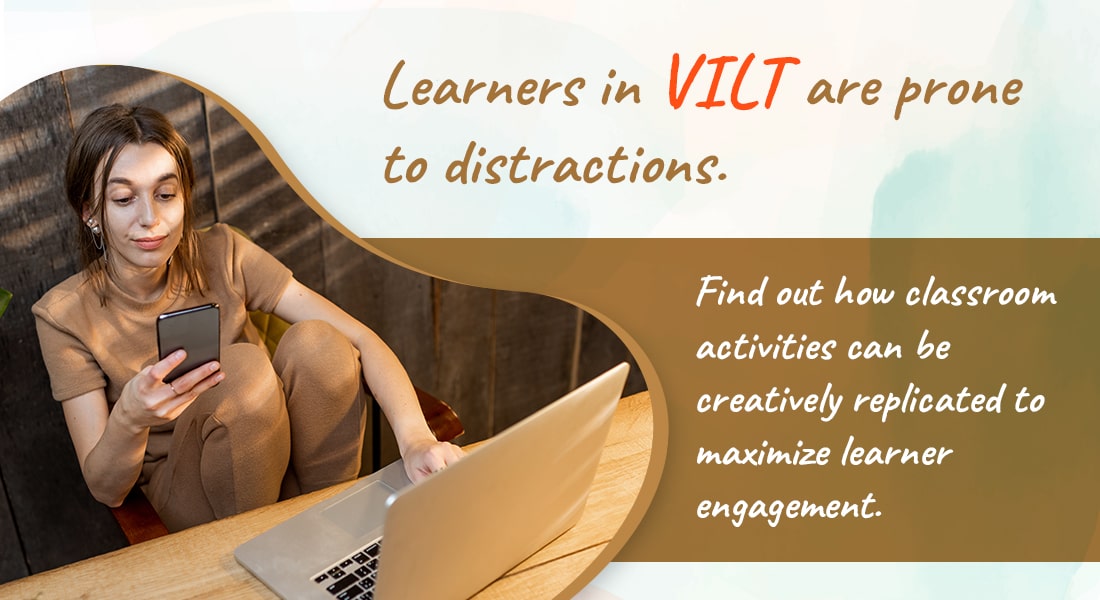Can Virtual Instructor-led Training Really Replace the Classroom?

Virtual instructor-led training (VILT) has emerged like a phoenix from the embers of corporate training that was left badly affected by the pandemic. And as organizations today are opting more and more for VILT, it does seem to be a good replacement for face-to-face classroom training.

There is no doubt that instructor-led training (ILT) was one of the best training formats that was available for employee training in the pre-COVID era. In spite of the high cost, time investment, and the logistic hassles involved in organizing ILT sessions, especially for huge numbers of geographically dispersed employees, it remained the gold standard of corporate training. Though organizations were slowly shifting (at least part of) their training into self-paced eLearning, classroom training was still the mainstay of training in many organizations.
Advantages of VILT
- Avoiding the hassles of travel, logistics, and space for training
- Facilitating training irrespective of learners’ location
- Offering the presence of an instructor in the session
- Providing customized content
- Tracking learners’ performance
But all that changed in the blink of an eye when the world woke up to a pandemic of epic proportions. Training managers were left scurrying for feasible options to ensure their training initiatives could go on. And this was especially hard on those organizations who hadn’t yet ventured into eLearning. Because creating eLearning courses does take time, though they are more cost and time effective in the long run.
So, how can VILT help your training initiatives, and is it really a worthy replacement for classroom training? Let’s explore in this blog.
What is VILT?
Virtual instructor-led training or VILT is a form of synchronous online training that is delivered in a virtual environment with the instructor and learners participating in the session at the same time, but from different locations.
It offers learners all the benefits of human interaction in a brick-and-mortar classroom without the hassles of travel, logistics, and space – through advances in technology leading to the availability of videoconferencing and other web conference tools.
Apart from avoiding the costs involved in arranging an off-site training session, VILT is accessible to employees in multiple locations. These teams can attend the training at the same time from different locations to receive the same training. A trainer can deliver virtual training to learners at multiple locations using an online tool that allows two-way communication.
Explore how to motivate and excite learners in the virtual class.
Information can be shared with the learners in the form of videos, documents, presentations, and written notes during the session. Learners can also participate in forums and discussions and take notes.
Advantages of VILT
Training irrespective of learner’s location: VILT gives learners the convenience of joining the session from wherever they are, without actually having to travel to the training location.
Presence of instructor: The presence of an instructor allows for interactivity – learners can share opinions, get doubts clarified, and participate in discussions.
Customized content: Once learners finish the VILT session, they can be given online modules for further learning. VILT provides the convenience of delivering necessary training for a task in a short span of time. Information can be delivered quickly. Changes in the industry, market trends, product updates can be communicated to employees through VILT sessions.
Tracking of learners’ performance: Finding how much learners have learned is possible through real-time activities in the form of polls or questions. Learners’ performance can also be tracked using an LMS or the built-in analytics that comes with the tools used for VILT.
Drawbacks of VILT
VILT is not exempt from drawbacks. One of them is the inability of the instructor to address the concerns of every user personally. As the training is online, the instructor does not have the visual cues that help the classroom instructor gauge learner interest and engagement. He/she cannot assess if the learners are paying attention or are engaged in the session, and this becomes pertinent especially when learners might be having numerous distractions at their desk or computer. This is probably one of the biggest limitations of virtual classrooms.
Also, as the instructor and learners are required to attend the session at the same time, the timing of the scheduled VILT session may not be convenient to learners from different time zones that require them to log in late or in the early hours of the day.
Another disadvantage is the tight timeframes in which these sessions are held. Both ILT and VILT sessions are expected to be completed in a fixed amount of time and rarely provide the luxury of being carried forward to the next session. The facilitator has to time his delivery perfectly based on the time available without rushing through the session (which might overwhelm learners) or being too slow and putting learners to sleep.
Overcoming the Drawbacks to VILT
Despite these drawbacks, VILT can be an exciting alternative to ILT because none of these drawbacks is unsurmountable. Classroom activities can be creatively replicated for the VILT to maximize learner engagement.
And you can use polls, chat, breakout rooms, annotations, and workbook activities to keep learners engaged and immersed in the training.
Polls help collect learners’ opinions and feedback. They can also be used to:
- Stimulate recall of prior knowledge
- Recap/summarize a learning point
- Quiz learners on a topic just covered
Chats enable communication between learners and instructors. They can be:
- Private to facilitate one-on-one interactions
- Public to share global updates and instructions
Breakout rooms are perhaps the most effective feature that replicates the collaboration and peer-to-peer interaction of a physical classroom. They are virtual rooms where small groups of learners can meet to discuss, share opinions, or participate in group activities.
In its simplest form, annotations enable learners to synchronously type text on a shared whiteboard or pick favorites from a pool of alternatives.
Worksheet activities in the virtual classroom have been an all-time favorite for learners to have fun while brainstorming on strategy and planning, team building, communication exercises, leadership exercises, and more.
In Conclusion
Virtual instructor-led training works well when you need to train a large group of people at short notice or want to save the cost of organizing an offsite training session. For situations that may require a face-to-face classroom session, why not use your classroom instructors to hold a VILT session while providing them with the required virtual training facilities and support for rewriting the ILT materials for the VILT format?




![4 Tips for a Successful Virtual Instructor-led Training [Infographic]](https://blog.commlabindia.com/hubfs/Imported_Blog_Media/virtual-instructor-led-training-success-tips-info.jpg)
![3 Key Considerations While Converting Classroom Training Material to VILT [SlideShare]](https://blog.commlabindia.com/hubfs/Imported_Blog_Media/classroom-vilt-conversion-key-considerations-ensure-success-slideshare.png)